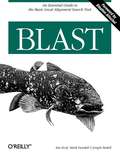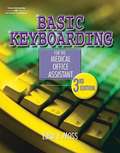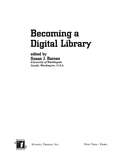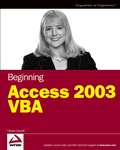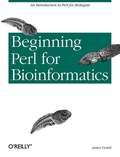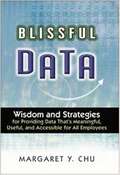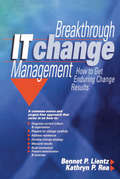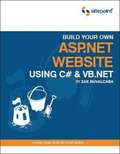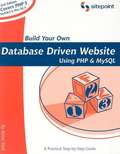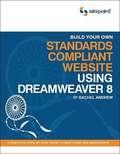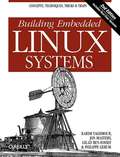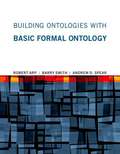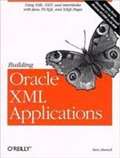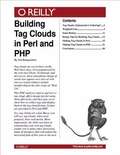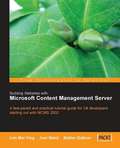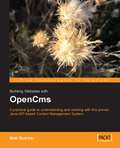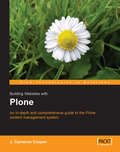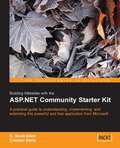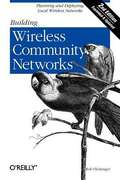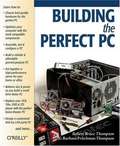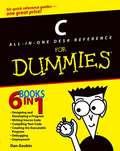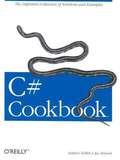- Table View
- List View
BLAST
by Joseph Bedell Ian Korf Mark YandellSequence similarity is a powerful tool for discovering biological function. Just as the ancient Greeks used comparative anatomy to understand the human body and linguists used the Rosetta stone to decipher Egyptian hieroglyphs, today we can use comparative sequence analysis to understand genomes. BLAST (Basic Local Alignment Search Tool), is a sophisticated software package for rapid searching of nucleotide and protein databases. It is one of the most important software packages used in sequence analysis and bioinformatics. Most users of BLAST, however, seldom move beyond the program's default parameters, and never take advantage of its full power. BLAST is the only book completely devoted to this popular suite of tools. It offers biologists, computational biology students, and bioinformatics professionals a clear understanding of BLAST as well as the science it supports. This book shows you how to move beyond the default parameters, get specific answers using BLAST, and how to interpret your results. The book also contains tutorial and reference sections covering NCBI-BLAST and WU-BLAST, background material to help you understand the statistics behind BLAST, Perl scripts to help you prepare your data and analyze your results, and a wealth of tips and tricks for configuring BLAST to meet your own research needs. Some of the topics covered include: BLAST basics and the NCBI web interface How to select appropriate search parameters BLAST programs: BLASTN, BLASTP, BLASTX, TBLASTN, TBLASTX, PHI-BLAST, and PSI BLAST Detailed BLAST references, including NCBI-BLAST and WU-BLAST Understanding biological sequences Sequence similarity, homology, scoring matrices, scores, and evolution Sequence Alignment Calculating BLAST statistics Industrial-strength BLAST, including developing applications with Perl and BLAST BLAST is the only comprehensive reference with detailed, accurate information on optimizing BLAST searches for high-throughput sequence analysis. This is a book that any biologist should own.
Basic Keyboarding for the Medical Office Assistant (3rd Edition)
by Edna Jean MossThis is a basic keyboarding book for medical assistants, medical secretaries and transcriptionists that include medical terminology case histories, technical information, and medical timed writings that is needed for any medical facility and all personnel
Becoming a Digital Library (Books In Library And Information Science Ser. #Vol. 63)
by Susan J. BarnesThis excellent reference traces the construction and maintenance of the digital collections and services that have been available day in and day out to users worldwide for more than a decade. It examines applicable guidelines for any library looking to build and manage systems, conduct and evaluate projects, and scout new directions for mainstreaming and hybridizing the building of a digital library. Including contributions from seasoned experts in specializations such as staffing, collection development, and technology project management for digital libraries, Becoming a Digital Library discusses the techniques for finding and training the right people to build a digital library.
Beginning Access 2003 VBA
by Denise M. GosnellWhat is this book about?Written by an Access programmer with more than 10 years of VBA experience, this is the perfect guide for Access users who are ready to take their databases to the next level, or for programmers who are new to Access or VBA. Veteran Access developer Denise Gosnell shows readers the ins and outs of Access VBA and provides plenty of source code, and fully developed sample applications to guide you along the way.Not only do readers learn to build "stand-alone" desktop applications, but readers also learn how to integrate Access applications with Web Services, and SQL Server.
Beginning Perl for Bioinformatics
by James TisdallWith its highly developed capacity to detect patterns in data, Perl has become one of the most popular languages for biological data analysis. But if you're a biologist with little or no programming experience, starting out in Perl can be a challenge. Many biologists have a difficult time learning how to apply the language to bioinformatics. The most popular Perl programming books are often too theoretical and too focused on computer science for a non-programming biologist who needs to solve very specific problems. Beginning Perl for Bioinformatics is designed to get you quickly over the Perl language barrier by approaching programming as an important new laboratory skill, revealing Perl programs and techniques that are immediately useful in the lab. Each chapter focuses on solving a particular bioinformatics problem or class of problems, starting with the simplest and increasing in complexity as the book progresses. Each chapter includes programming exercises and teaches bioinformatics by showing and modifying programs that deal with various kinds of practical biological problems. By the end of the book you'll have a solid understanding of Perl basics, a collection of programs for such tasks as parsing BLAST and GenBank, and the skills to take on more advanced bioinformatics programming. Some of the later chapters focus in greater detail on specific bioinformatics topics. This book is suitable for use as a classroom textbook, for self-study, and as a reference. The book covers: Programming basics and working with DNA sequences and strings Debugging your code Simulating gene mutations using random number generators Regular expressions and finding motifs in data Arrays, hashes, and relational databases Regular expressions and restriction maps Using Perl to parse PDB records, annotations in GenBank, and BLAST output
Beginning Web Programming with HTML, XHTML, and CSS
by Jon DuckettWhat is this book about?Beginning Web Programming with HTML, XHTML, and CSS teaches you how to write Web pages using HTML, XHTML, and CSS. It follows standards-based principles, but also teaches readers ways around problems they are likely to face using (X)HTML.While XHTML is the "current" standard, the book still covers HTML because many people do not yet understand that XHTML is the official successor to HTML, and many readers will still stick with HTML for backward compatibility and simpler/informal Web pages that don't require XHTML compliance.The book teaches basic principles of usability and accessibility along the way, to get users into the mode of developing Web pages that will be available to as many viewers as possible from the start. The book also covers the most commonly used programming/scripting language -- JavaScript -- and provides readers with a roadmap of other Web technologies to learn after mastering this book to add more functionality to their sites.
Blissful Data: Wisdom And Strategies For Providing Meaningful, Useful, And Accessible Data For All Employees
by Margaret Y. ChuAnalyzing information and acting accordingly is a key strategic goal of every business. But vast quantities of data are of little use if they are not structured and kept in such a way as to be readily accessible and applicable. Only optimally organized information can drive maximum productivity. Blissful Data is a reader-friendly book that reveals what it takes to achieve a state of perfect organization within the environment of a successful data warehouse. This timely book will help the reader: * understand how data evolves into information that drives better decision making * recognize the pitfalls, caused by people and politics, that lead to short-sighted solutions and long-term problems * manage data warehousing costs, performance, and expectations effectively * apply project management fundamentals to data warehouse endeavors. Blissful Data includes dozens of examples, as well as case studies illustrating successful, unsuccessful, and disastrous data warehouse strategies.
Breakthrough IT Change Management
by Bennet Lientz Kathryn ReaThis is a *different* book on change management. Using commonsense and practical advice tested in their work with hundreds of organizations, the authors walk the reader through clear guidelines and checklists to implement change that works. Readers will develop a change management strategythat starts by diagnosing the current culture and organization, then prepares for change carefully, addresses resistance to change, develops the change strategy, measures results, builds momentum for further change, and prevents deterioration and reversion. The authors then apply their framework to two areas that are major targets for change management: implementing new technology and systems and implementing successful e-business strategies. Included throughout are real-world examples from a number of industries and government.
Build Your Own ASP.NET Website Using C# & VB.NET
by Zak RuvalcabaA tutorial style book for absolute beginners that walks readers through an introduction to databases and programming concepts and then shows them how to build practical applications using Microsoft's technology. Build Your Own ASP.NET Website Using C# & VB.NET guides readers through obtaining, installing and configuring all the necessary software to develop dynamic Websites. Then, it takes readers step-by-step through the process of creating full-blown, practical applications including an intranet, shopping cart with Paypal credit card processing and more. Throughout, the book focuses on best-practice code, ensuring application security and creating professional error handling routines. Unlike most beginner books, SitePoint allow readers to choose between two programming languages, VB.NET or c#, when creating any of the applications in the book.
Build Your Own Database-Driven Website Using PHP and MySQL, Third Edition
by Kevin YankBuild Your Own Database-Driven Website Using PHP and MySQL is a practical guide for first-time users of PHP and MySQL that teaches readers by creating a fully working Content Management System, Shopping Cart and other real-world applications. There has been a marked increase in the adoption of PHP, most notably in the beginning to intermediate levels. PHP now boasts over 30% of the server side scripting market (Source: http://www.php.weblogs.com ). The previous edition sold over 17,000 copies exclusively through http://www.sitepoint.com alone. With the release of PHP 5, SitePoint have updated this bestseller to reflect best practice web development using PHP 5 and MySQL 4. The 3rd Edition includes more code examples and also a new bonus chapter on structured PHP Programming which introduces techniques for organizing real world PHP applications to avoid code duplication and ensure code is manageable and maintainable. The chapter introduces features like include files, user-defined function libraries and constants, which are combined to produce a fully functional access control system suitable for use on any PHP Website.
Build Your Own Standards Compliant Website Using Dreamweaver 8
by Rachel AndrewBuild Your Own Standards Compliant Website with Dreamweaver 8 is written for any user of Dreamweaver who wants to create standards compliant, usable and fully accessible websites. By applying Web Standards and best-practices, readers will learn to create fast-loading, easy-to-maintain and cross-browser compatible Websites. This book focuses on using XHTML and semantic markup, CSS Layouts, and accessibility guidelines to show users how to make the most of Dreamweaver 8.
Building Embedded Linux Systems
by Karim Yaghmour Jonathan Masters Gilad Ben-YossefThere's a great deal of excitement surrounding the use of Linux in embedded systems -- for everything from cell phones to car ABS systems and water-filtration plants -- but not a lot of practical information. Building Embedded Linux Systems offers an in-depth, hard-core guide to putting together embedded systems based on Linux. Updated for the latest version of the Linux kernel, this new edition gives you the basics of building embedded Linux systems, along with the configuration, setup, and use of more than 40 different open source and free software packages in common use. The book also looks at the strengths and weaknesses of using Linux in an embedded system, plus a discussion of licensing issues, and an introduction to real-time, with a discussion of real-time options for Linux. This indispensable book features arcane and previously undocumented procedures for: Building your own GNU development toolchain Using an efficient embedded development framework Selecting, configuring, building, and installing a target-specific kernel Creating a complete target root filesystem Setting up, manipulating, and using solid-state storage devices Installing and configuring a bootloader for the target Cross-compiling a slew of utilities and packages Debugging your embedded system using a plethora of tools and techniques Using the uClibc, BusyBox, U-Boot, OpenSSH, thttpd, tftp, strace, and gdb packages By presenting how to build the operating system components from pristine sources and how to find more documentation or help, Building Embedded Linux Systems greatly simplifies the task of keeping complete control over your embedded operating system.
Building Ontologies with Basic Formal Ontology
by Robert Arp Barry Smith Andrew D. SpearIn the era of "big data," science is increasingly information driven, and the potential for computers to store, manage, and integrate massive amounts of data has given rise to such new disciplinary fields as biomedical informatics. Applied ontology offers a strategy for the organization of scientific information in computer-tractable form, drawing on concepts not only from computer and information science but also from linguistics, logic, and philosophy. This book provides an introduction to the field of applied ontology that is of particular relevance to biomedicine, covering theoretical components of ontologies, best practices for ontology design, and examples of biomedical ontologies in use.After defining an ontology as a representation of the types of entities in a given domain, the book distinguishes between different kinds of ontologies and taxonomies, and shows how applied ontology draws on more traditional ideas from metaphysics. It presents the core features of the Basic Formal Ontology (BFO), now used by over one hundred ontology projects around the world, and offers examples of domain ontologies that utilize BFO. The book also describes Web Ontology Language (OWL), a common framework for Semantic Web technologies. Throughout, the book provides concrete recommendations for the design and construction of domain ontologies.
Building Oracle XML Applications
by Steve MuenchXML (Extensible Markup Language)has emerged as the industry standard for describing data for e-commerce, particularly for business-to-business exchange. Oracle Corporation supports XML in a wide range of products, and the company describes Oracle8 i, its "Internet database" as "the first XML-enabled database." XML is a key part of the company's e-business strategy. Building Oracle XML Applications gives both Java and PL/SQL developers a rich and detailed look at the range of available Oracle XML technologies. The book shows how to combine the power of XML and XSLT with the speed, functionality, and reliability of the Oracle database to build flexible applications. The author delivers nearly 800 pages of entertaining text, helpful and time-saving hints, and extensive examples that developers can put to use immediately to build custom XML applications. Products covered include: XSQL pages and the XSQL servlet JDeveloper XSLT Processor XML Parser interMedia Advanced Queuing The accompanying CD-ROM contains JDeveloper 3.1, an integrated development environment for Java developers.
Building Tag Clouds in Perl and PHP
by Jim BumgardnerTag clouds are everywhere on the web these days. First popularized by the web sites Flickr, Technorati, and del.icio.us, these amorphous clumps of words now appear on a slew of web sites as visual evidence of their membership in the elite corps of "Web 2.0." This PDF analyzes what is and isn't a tag cloud, offers design tips for using them effectively, and then goes on to show how to collect tags and display them in the tag cloud format. Scripts are provided in Perl and PHP. Yes, some have said tag clouds are a fad. But as you will see, tag clouds, when used properly, have real merits. More importantly, the skills you learn in making your own tag clouds enable you to make other interesting kinds of interfaces that will outlast the mercurial fads of this year or the next.
Building Websites with Microsoft Content Management Server
by Lim Ying Joel WardYears of active participation in MCMS newsgroups and mailing lists mean that the authors? hard-won experience puts them in the ideal position to tell you what you really need to know to master the system.An example site is developed throughout the book, at every point providing clear and practical demonstrations of the relevant ideas. Once you have mastered the basics, the book leads you onto more advanced and powerful techniques, allowing you to get the most from this awesome system.This book is written for developers who are part of a dynamic organization that has decided to evaluate or deploy MCMS and require the skills to make it happen.The book presumes a working knowledge of the .NET Framework and familiarity with the C# language, but no prior knowledge of MCMS is required. To use this book, you will need access to Visual Studio. NET 2002 or 2003, SQL Server 2000, and an installation of MCMS 2002.This book is not aimed at the specific information needs of administrators or users of MCMS.
Building Websites with OpenCms
by Matt ButcherIf you are a web developer new to OpenCms, or are an experienced OpenCms developer who is looking to get the most from the system, then this is the book for you. A working knowledge of Java, JSP, and XML is required to get the most from OpenCms, and from this book.
Building Websites with Plone
by First Middle Last4000 character max. If you are only providing one description, this is the preferred one.
Building Websites with the ASP.NET Community Starter Kit
by Cristian Darie K. Scott AllenThis book isn't written as a standard tutorial, it has been broken down into two halves to give you full understanding of the Community Starter Kit and then the confidence to create, administer and customize your own site. The second half of the book includes plenty of code, but the emphasis is firmly on guiding you through the techniques to create, extend and customize your own module. This book has been written for ASP.NET developers with a sound grasp of C# and access to Visual Studio .NET. This book uses the Visual Studio. NET version of the ASP.NET Community Starter Kit.
Building Wireless Community Networks, 2nd Edition
by Rob FlickengerBuilding Wireless Community Networks is about getting people online using wireless network technology. The 802.11b standard (also known as WiFi) makes it possible to network towns, schools, neighborhoods, small business, and almost any kind of organization. All that's required is a willingness to cooperate and share resources. The first edition of this book helped thousands of people engage in community networking activities. At the time, it was impossible to predict how quickly and thoroughly WiFi would penetrate the marketplace. Today, with WiFi-enabled computers almost as common as Ethernet, it makes even more sense to take the next step and network your community using nothing but freely available radio spectrum. This book has showed many people how to make their network available, even from the park bench, how to extend high-speed Internet access into the many areas not served by DSL and cable providers, and how to build working communities and a shared though intangible network. All that's required to create an access point for high-speed Internet connection is a gateway or base station. Once that is set up, any computer with a wireless card can log onto the network and share its resources. Rob Flickenger built such a network in northern California, and continues to participate in network-building efforts. His nuts-and-bolts guide covers: Selecting the appropriate equipment Finding antenna sites, and building and installing antennas Protecting your network from inappropriate access New network monitoring tools and techniques (new) Regulations affecting wireless deployment (new) IP network administration, including DNS and IP Tunneling (new) His expertise, as well as his sense of humor and enthusiasm for the topic, makes Building Wireless Community Networks a very useful and readable book for anyone interested in wireless connectivity.
Building the Perfect PC
by Robert Bruce Thompson Barbara Fritchman ThompsonWith off-the-shelf computer systems to fit any budget or requirement, some people might wonder why you'd want to build your own. They don't understand that for many computer users, a ready-made system is about as satisfying as popping a frozen dinner in the microwave when you you'd rather have real food instead. Sure, it works, but it's not exactly what you need or want. There's a lot to be said for a computer that has exactly the quality components you choose, by the manufacturers you choose, rather than the conveniently bundled assortment made for your price point. But perhaps you've stopped short of building your own because you're inexperienced or you're concerned it won't come out right. After all, you want your computer to be perfect. Hesitate no longer: Building the Perfect PC delivers end-to-end instructions (that even inexperienced PC-builders can follow) for creating your ideal machine. Written by hardware experts Robert Bruce Thompson and Barbara Fritchman Thompson, this book covers it all, beginning with the various reasons why you'd want to build your own PC, planning and picking out the components, and putting it all together. The book outlines a variety of complete systems and all of their components, including a small form factor PC; a middle-of-the-road "sweet spot" system with top-notch components; and a top-end gaming PC with high-end video, a fast processor, and enough RAM to make your palms sweat just thinking about it. Straightforward language, clear directions, and extensive illustrations make this guide a breeze for computer builders of any level to follow--even those with little or no experience. If you've yearned for a quality machine with high-end components that suit your needs, then Building the Perfect PC will put you where you want to be: in control of your computer system.
Business Computer Information Systems I (Texas Edition)
by Prentice HallBusiness Computer information Systems I presents the basic concepts and skills of Microsoft Office XP (Microsoft Word, Microsoft Excel, Microsoft Access, Microsoft PowerPoint and Microsoft Outlook and also introduces fundamental computer concepts.
Business Computer Information Systems II (Texas Edition)
by Pearson EducationBusiness Computer Information Systems II presents advanced concepts and skills of Microsoft Office XP (Microsoft Word, Microsoft Excel, Microsoft Access, and Microsoft Outlook®). Through a learn-by-doing approach, students are challenged to master Microsoft Office within a business context. Additional features throughout the book also provide insight into how software can be used in other academic areas and in the business world.
C All-in-One Desk Reference For Dummies
by Dan GookinCovers everything users need to get up to speed on C programming, including advanced topics to take their programming skill to the next level Walks C programmers through the entire development cycle of a C program-designing and developing the program, writing source code, compiling the code, linking the code to create the executable programs, debugging, and deployment Provides thorough coverage of keywords, program flow, conditional statements, constants and variables, numeric values, arrays, strings, functions, pointers, debugging, prototyping, and much more Addresses some advanced programming topics such as graphics and game programming as well as Windows and Linux programming Includes dozens of sample programs that readers can adapt and modify for their own uses Written by the author of the first-ever For Dummies book-a man known for his ability to take complex material and present it in a way that makes it simple and fun
C# Cookbook
by Jay Hilyard Stephen TeilhetThe C# Cookbook offers a definitive collection of solutions and examples for this new programming language. Recipes range from simple tasks to the more complex, and are organized with respect to the types of problems you'll need to solve as you progress in your experience as a C# programmer. Nearly every recipe contains a complete, documented code sample showing you how to solve the specific problem, as well as a discussion of how the underlying technology works and a discussion of alternatives, limitations, and other considerations where appropriate.
